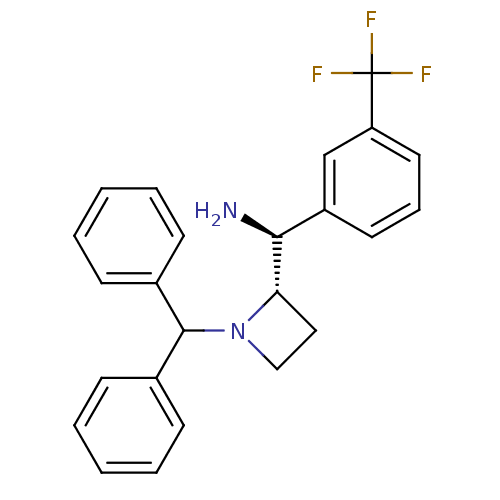BDBM50120147 C-[(S)-C-((S)-1-Benzhydryl-azetidin-2-yl)-C-(3-trifluoromethyl-phenyl)]-methylamine::CHEMBL316961
SMILES N[C@H]([C@@H]1CCN1C(c1ccccc1)c1ccccc1)c1cccc(c1)C(F)(F)F
InChI Key InChIKey=GAEAFMJGLPCGOT-VXKWHMMOSA-N
Data 8 KI
Activity Spreadsheet -- Enzyme Inhibition Constant Data from BindingDB
 Found 8 hits for monomerid = 50120147
Found 8 hits for monomerid = 50120147
Affinity DataKi: 31nMAssay Description:Binding affinity at human opioid receptor kappa 1 was determined by using [3H]diprenorphine radioligand in CHO cell membranes at a concentration of 0...More data for this Ligand-Target Pair
Affinity DataKi: 31nMAssay Description:Binding affinity at human ORL1 receptor was determined by using [125I]nociceptin radioligand in Chinese hamster ovary (CHO) cell membranes at a conce...More data for this Ligand-Target Pair
TargetKappa-type opioid receptor(Homo sapiens (Human))
Schering-Plough Research Institute
Curated by ChEMBL
Schering-Plough Research Institute
Curated by ChEMBL
Affinity DataKi: 1.63E+3nMAssay Description:Binding affinity at human opioid receptor kappa 1 was determined by using [3H]diprenorphine radioligand in CHO cell membranes at a concentration of 0...More data for this Ligand-Target Pair
TargetKappa-type opioid receptor(Homo sapiens (Human))
Schering-Plough Research Institute
Curated by ChEMBL
Schering-Plough Research Institute
Curated by ChEMBL
Affinity DataKi: 1.63E+3nMAssay Description:Binding affinity at human opioid receptor kappa 1 was determined by using [3H]diprenorphine radioligand in CHO cell membranes at a concentration of 0...More data for this Ligand-Target Pair
TargetMu-type opioid receptor(Homo sapiens (Human))
Schering-Plough Research Institute
Curated by ChEMBL
Schering-Plough Research Institute
Curated by ChEMBL
Affinity DataKi: 1.96E+3nMAssay Description:Binding affinity at human opioid receptor mu 1 was determined by using [3H]diprenorphine radioligand in CHO cell membranes at a concentration of 0.12...More data for this Ligand-Target Pair
TargetMu-type opioid receptor(Homo sapiens (Human))
Schering-Plough Research Institute
Curated by ChEMBL
Schering-Plough Research Institute
Curated by ChEMBL
Affinity DataKi: 1.97E+3nMAssay Description:Binding affinity at human opioid receptor mu 1 was determined by using [3H]diprenorphine radioligand in CHO cell membranes at a concentration of 0.12...More data for this Ligand-Target Pair
TargetDelta-type opioid receptor(Homo sapiens (Human))
Schering-Plough Research Institute
Curated by ChEMBL
Schering-Plough Research Institute
Curated by ChEMBL
Affinity DataKi: 6.08E+3nMAssay Description:Binding affinity at human opioid receptor delta 1 was determined by using [3H]diprenorphine radioligand in CHO cell membranes at a concentration of 0...More data for this Ligand-Target Pair
TargetDelta-type opioid receptor(Homo sapiens (Human))
Schering-Plough Research Institute
Curated by ChEMBL
Schering-Plough Research Institute
Curated by ChEMBL
Affinity DataKi: 6.09E+3nMAssay Description:Binding affinity at human opioid receptor delta 1 was determined by using [3H]diprenorphine radioligand in CHO cell membranes at a concentration of 0...More data for this Ligand-Target Pair
